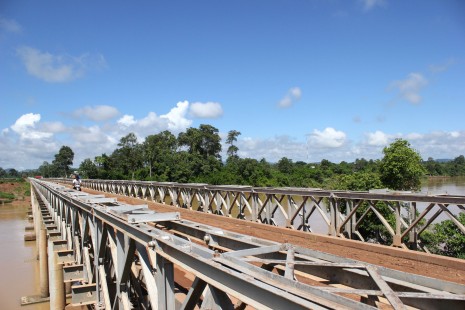O’YADAW DISTRICT, Ratanakkiri province – Construction of a special economic zone (SEZ) near the Vietnamese border in Ratanakkiri province’s eastern O’Yadaw district is on track, but who exactly will avail of the facility and its services remains a mystery—even for senior provincial officials.
The latest announced venture of agro-industry land concession giant Try Pheap Import Export, the SEZ in Paknhai commune is situated nearby businessman Try Pheap’s new border-hugging casino and will be a sizable 136 hectares when completed, according to government documents.

Despite the key location and uniqueness of the SEZ, Ratanakkiri governor Pao Ham Phan said Tuesday he knows almost nothing about the project, which came to light in a sub-decree, signed on May 7 by Prime Minister Hun Sen.
“Now it is under construction,” Mr. Ham Phan said. “Maybe it will be a dry port,” he said, referring to zones where goods are stored before trans-shipment.
Similar head-scratching about the SEZ was evident among residents of Paknhai commune during a visit to the area on Friday, while local government officials said they were completely in the dark.
O’Yadaw district governor Dak Sar said he knew nothing while Paknhai commune chief Rocham Hlech said the first he had heard about the nascent industrial zone in his rural area was from reporters.
“We are not informed of the SEZ,” Mr. Hlech said. “I have no idea what it will be designed for.”
Try Pheap company officials were similarly unable to impart details regarding the SEZ, particularly its intended purpose and clientele in a lightly populated area of the country where industry and investment consists primarily of land concessions planted with rubber and cassava—and in which Try Pheap has a significant share.
Bi Chivoandara, a provincial representative of Try Pheap in Ratanakkiri, declined to comment and referred questions to company management, whose contact details he did not provide.
The sub-decree establishing the SEZ in law also provides few details, but instructs all relevant ministries and provincial governors to facilitate its construction. According to the Council for the Development of Cambodia, a SEZ can include a general industrial zone, an export-processing zone and a production area, which can also have a free trade area, service area, residential area and tourist area.
Mr. Pheap has risen from relative obscurity in the past several years to own a burgeoning portfolio of businesses spanning the leasing of an island off the coast, mining interests, massive land concessions and his new casino.
“Now the casino is not completed yet, but they usually hold cockfighting three days a week,” Mr. Hlech, the commune chief said Tuesday, adding that customers are Vietnamese and Cambodian gamblers.
In Andong Meas district, evidence of Mr. Pheap’s investment prominence are evident in the 252-meter-long metal bridge spanning the Sesan River, which he built, offering a road connection between the two halves of the district, and access to government-granted land concessions, including those held by Try Pheap .
In February, the Ministry of Agriculture signed a deal with Mr. Pheap to permit his firm to purchase all trees felled inside economic land concessions in the entire province of Ratanakkiri. Explaining the decision, provincial governor Mr. Ham Phan said in May that the monopoly would help regulate the market for legal timber in the province. Local rights group Adhoc said the deal could spur illegal logging and accelerate deforestation in the province as it would offer a means for the unscrupulous to illegally fell trees and process them legally.
In February 2011, Mr. Pheap was granted two 70-year leases covering 18,855 hectares of land to operate land concessions within the Virachey National Park.
The government has granted land concessions in Ratanakkiri to 27 companies covering a total of 222,933 hectares land, according to figures compiled by local human rights group Adhoc.
According to Adhoc, almost half of these concessions—108,513 hectares—are situated inside the protected Virachey Park, known locally as the “Dragon’s Tail,” which at 330,000 hectares is an Asean Heritage-listed park forest that is considered a key regional conservation area.
Virachey Park’s designation as a protected area in the Asean bloc remains on the Asean Heritage list despite the agro-industry incursions. The next Asean Heritage Parks conference will take place in the Philippines in October.